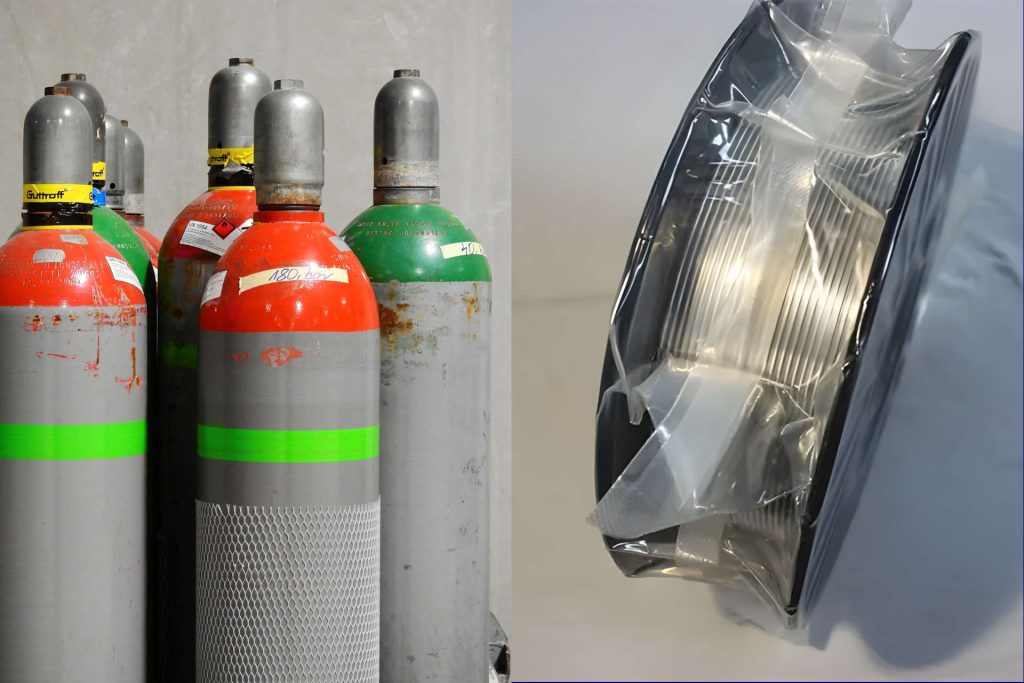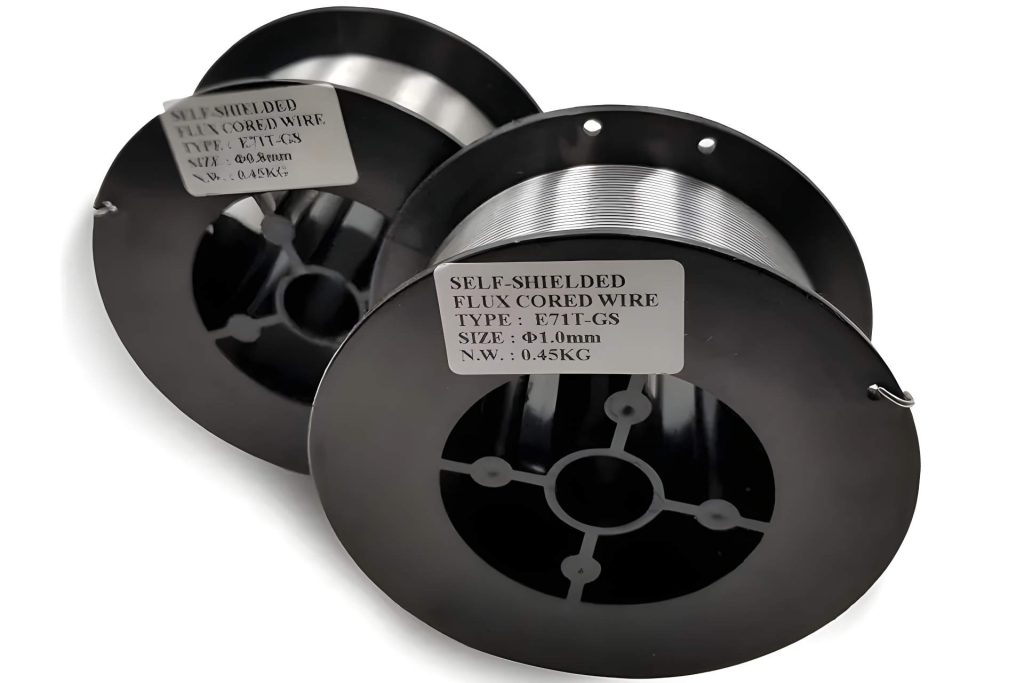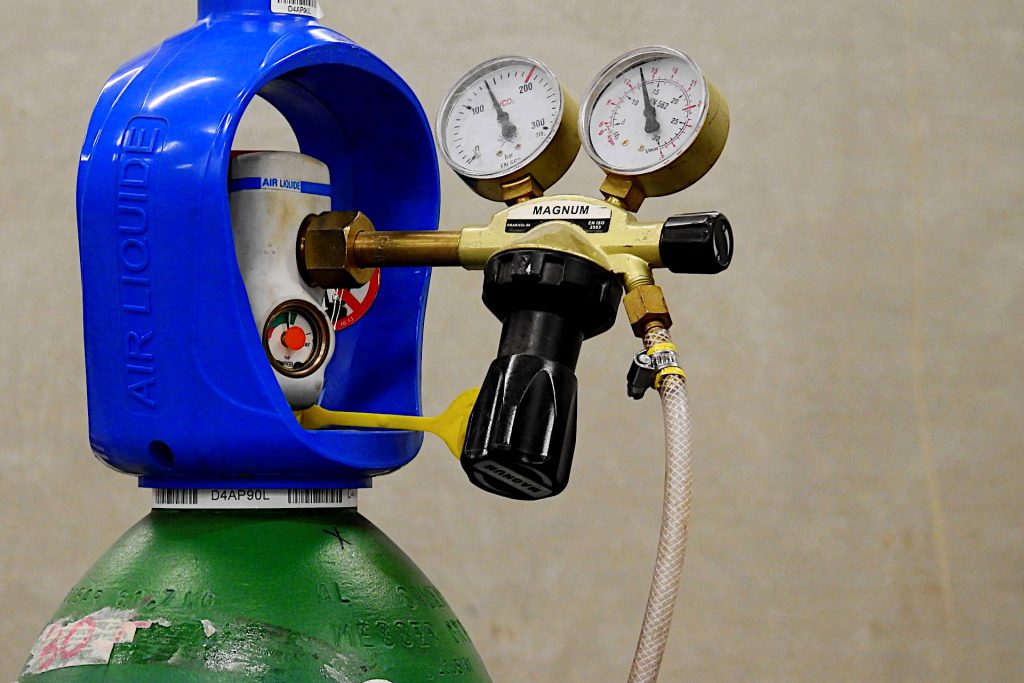Does Flux Core Welding Require Gas?
americanindustrialsupl and its partners may earn a commission if you purchase a product through one of our links.
A common question often asked by new welders is new welders have questions about whether or not it requires a shielding gas. The short answer is – it depends! Flux core welding refers to a process that uses a wire electrode filled with flux. This flux protects the weld from contamination during welding. However, there are two main types of flux core welding: self-shielded and gas-shielded, sometimes referred to as dual shielded .
Self-shielded flux core welding does not utilize an external shielding gas as the flux provides protection. This makes it suitable for outdoor welding applications. Gas-shielded flux core welding does require an external shielding gas for additional protection, making it better for indoor uses.
Below, we’ll explore both methods of flux core welding in-depth and look at the factors affecting whether to use gas-shielded or self shielded flux core method, considering the pros and cons of using shielding gas versus not using it. We’ll also discuss key factors like weld quality, equipment needs, safety considerations, and more. Whether you’re new to welding or an experienced veteran, this info will help you decide if gas is necessary for your flux core welding projects.
Flux Core Wire
Overview of Flux Core Welding

Before diving into whether or not flux core welding requires a shielding gas, it’s helpful to understand some basics about the process. Flux core welding utilizes a consumable tubular electrode wire filled with flux on the inside. As the wire melts and feeds into the weld pool, the inner flux is exposed. This flux serves several key purposes:
- Protects molten metal from contamination
- Regulates the arc and improves weld quality
- Alloys with the weld pool to improve mechanical properties
- Forms slag to protect the solidifying weld
The American Welding Society (AWS) classifies this process as flux core arc welding (FCAW). It’s an arc welding process that is somewhat similar to MIG welding. However, the key difference is that flux core welding uses the flux within the wire, rather than requiring an external shielding gas.
There are a two main types of flux core welding:
- Self-shielded flux core welding – The flux in the wire fully protects the weld, so no external gas is needed. The flux creates CO2 when burned, shielding the weld.
- Gas-shielded flux core welding – An external shielding gas is used for additional protection of the weld pool. Argon or Argon/CO2 blends are common.
Flux core welding offers numerous benefits that make it a popular choice:
- Ability to weld outdoors and in windy conditions (with self-shielded wire)
- Higher deposition rates compared to other welding processes
- Minimal need for pre-cleaning of joint area
- Can weld thicker and heavier sections of material
- More portable than MIG welding which requires large external gas tanks
However, there are some downsides as well:
- Increased smoke/fumes created by the burning flux
- More spatter versus gas-shielded MIG welding
- Slag production which must be chipped off
With this basic background on the flux core welding process, we can better understand whether or not to use a shielding gas. We’ll explore the key differences between self-shielded and gas-shielded methods in the next sections.
Types of Flux Core Welding
Now that we’ve covered some flux core welding basics, let’s explore the key differences between self-shielded and gas-shielded welding. Understanding these two main methods is essential to determining if a shielding gas is needed.
Self-Shielded Flux Core Welding
As the name suggests, this type of flux core welding does not require any external gas shielding. The flux inside the wire provides all the protection needed. Here are some key attributes:
- Portable – No need for gas tanks makes it completely portable. Perfect for outdoor sites.
- Versatile – Can weld thicker metals like construction materials or shipbuilding steels.
- Higher deposition – With no gas flow disruptions, it has a faster melting rate than gas-shielded.
- Outdoor uses – Wind or drafts do not affect the protective flux slag.
However, there are some downsides:
- Lower quality welds – More spatter, smoke, slag inclusions are possible.
- Slag removal – The slag leftover must be chipped off the weld afterwards.
- Fumes – Higher fume generation from the burning flux chemicals.
Overall, self-shielded flux core welding is an excellent choice when high portability, speed, and outdoor usage are priorities. The tradeoff is potentially lower weld quality compared to gas-shielded methods.
Gas-Shielded Flux Core Welding
This type of flux core welding utilizes both the flux in the wire and an external shielding gas for protection. The most common gases used are:
- Argon (Ar) – Provides a very stable arc but limited penetration.
- Carbon Dioxide (CO2) – Gives excellent penetration but less stable arc.
- Argon/CO2 Blends – Balances penetration and arc stability.
Here are some benefits of gas-shielded flux core welding:
- Smoother arc – More manageable and less spatter than self-shielded method.
- Improved weld appearance – Less discoloration and very little slag.
- Higher quality welds – Less risk of porosity or contamination in the weld.
- Thinner materials – The gas provides better welding capability on thinner metals.
And some potential drawbacks:
- Less portable – External shielding gas tank is required.
- Indoor use – Susceptible to drafts and air movement.
- Higher cost – The shielding gas adds extra expense to operating costs.
Gas-shielded flux core welding excels in applications where quality is critical – such as fabricating pressure vessels or structural steel. The tradeoff is slightly higher equipment costs and reduced portability.
Self-Shielded Flux Core Welding

Now that we’ve covered the basics of the two types, let’s do a deeper dive on self-shielded flux core welding. Understanding the intricacies of this method will provide insight on why it doesn’t require any external shielding gas.
How the Self-Shielded Process Works
The key advantage of self-shielded flux core welding is the portability it provides. But how does it work without any external gas? The flux inside the wire provides all the shielding. This flux contains the following key ingredients:
- Titania – Provides arc stabilization and slag formation
- Silicon/Manganese – Alloys for the weld to improve strength
- Limestone/Fluorspar – Slag formation and weld bead shape
- Iron Powder – Adds to the weld deposit and controls arc characteristics
As this tubular wire feeds into the arc and melts, the ingredients above burn and generate protective gases – primarily carbon dioxide (CO2). This CO2 gas envelops the arc and molten metal, shielding it from the atmosphere.
In essence, the wire contains its own built-in shielding mechanism. There’s no need for an external tank of gas.
Pros and Cons of Self-Shielded Welding
Outdoor welding is one of the biggest advantages of self-shielded flux core welding. It can be done in open yards, on construction sites, and under windy conditions. The protective slag and gases are not blown away.
Other benefits include:
- Faster travel speeds – Increased deposition rate over gas-shielded.
- Less pre-cleaning – The slag penetrates surface debris and oxides.
- Deeper penetration – Faster melting of the tubular wire increases penetration.
- Portability – No gas tanks required makes it highly portable.
However, the tradeoff comes in potentially lower weld quality:
- Porosity – Risk of gas pockets in the weld if slag doesn’t protect fully.
- Spatter – High volumes of spatter from the turbulent protective gases.
- Slag inclusions – Bits of slag can get trapped in the weld if not removed.
- Fumes – Burning flux produces increased fumes.
While these cons are manageable with good technique, self-shielded flux core welding will likely never match the cosmetic quality of gas-shielded welds.
When to Use Self-Shielded Welding
Here are some ideal applications for self-shielded flux core welding:
- Structural steel fabrication
- Shipbuilding and repair
- Pipeline welding
- Construction sites
- Farm/agriculture equipment repairs
- Heavy machinery/equipment repairs
- Anywhere portability and speed are critical
While the weld quality won’t match a gas-shielded weld, self-shielded flux core welding provides the ability to get the job done portably and quickly. Proper weld prep and joint design can also help minimize any potential quality issues.
Flux Core Wire
Advantages of Self-Shielded Flux Core Welding
Now that we’ve covered the basics of how self-shielded flux core welding works, let’s take a deeper look at some of the unique advantages and benefits it offers:
Portability
The portability of self-shielded flux core welding is by far its greatest advantage. Since the flux in the wire eliminates the need for external shielding gas, you can take it anywhere and weld:
- At remote job sites with no gas supply
- Outdoors in windy conditions
- Up on ladders or lifts
- In confined spaces with limited access
This allows welders to make repairs and complete projects wherever needed – without the burden of moving and setting up large gas tanks. The ability to weld portably is a huge benefit across many industries including construction, infrastructure, and transportation.
Higher Deposition Rates
Flux core welding generally has higher deposition rates than gas-shielded MIG welding. Why? Because there is no external gas flow to disrupt the continuous melting of the wire electrode into the weld pool.
Typical deposition rates with self-shielded wires are:
- 1/16″ Wire – Up to 14 lbs/hour
- 5/64″ Wire – Up to 23 lbs/hour
- 3/32″ Wire – Up to 40 lbs/hour
This improved melting rate gets the job done faster – saving time and money, especially on thicker materials.
Ability to Weld Outdoors
As mentioned earlier, the slag and gases from self-shielded flux core welding are not blown away by drafts or wind. This makes it the ideal choice for outdoor welding situations where shielding gas would be ineffective and get disturbed:
- Windy open job sites
- Breezy conditions near oceans/lakes
- Exposure to moving vehicles or equipment
While gas-shielded welding remains an indoor process, self-shielded flux core functions fine in outdoor environments.
Single Pass Welds on Thicker Metal
The higher deposition rates and improved penetration of self-shielded flux core welding mean you can often make welds on thicker materials with fewer passes. In some cases, a single pass weld on up to 1″ steel is achievable depending on wire size and parameters.
This improves productivity on materials like:
- Heavy machinery
- Agricultural equipment
- Steel fabrication
- Pressure vessels
- Structural steel construction
No Pre-Cleaning Required
Self-shielded flux core welding does not require extensive joint preparation or cleaning prior to welding. The slag melts and penetrates surface debris, oxides, paints, etc.
This means less time spent preparing materials for welding. Just tack the joint and start welding. The flux will do the rest.
Disadvantages of Self-Shielded Flux Core Welding
While self-shielded flux core welding has some excellent benefits, it also comes with tradeoffs. Understanding the potential drawbacks and downsides will help determine if it’s the best process for your welding projects.
Slag Production
All flux core welding results in slag production. This occurs as the flux ingredients melt and rise to the top of the weld while it solidifies. Self-shielded flux core produces a heavier slag layer than gas-shielded.
This slag must be chipped and cleaned off the weld bead once it cools. If any slag becomes trapped in the weld, it can cause weakness and inclusions. Removing slag takes additional time and a special chipping hammer.
While manageable, slag production is higher with self-shielded wires making cleanup more labor intensive.
Increased Spatter
Unfortunately, the turbulent gases created by the burning flux materials in self-shielded flux core welding lead to increased spatter. Small bits of molten metal go flying off the weld area during welding.
This extra spatter causes a few headaches:
- Creates smoke/fumes when the spatter hits the ground
- Can damage coated or finished surfaces near the weld area
- Leaves a mess requiring extra cleanup
While not detrimental to the weld itself, higher spatter rates make self-shielded flux core messier than gas-shielded methods.
Higher Fume Levels
The flux ingredients burning inside self-shielded flux core welding wires give off more visible smoke and fumes. Common ingredients like manganese, titanium oxide, and carbon dioxide produce airborne particulates when vaporized.
Welders must take precautions to avoid breathing these fumes:
- Wear an air-supplied respirator
- Provide general ventilation in confined spaces
- Use portable fume extractors when possible
Self-shielded flux core isn’t recommended without adequate fume control or respiratory protection.
Burn-Through Risk on Thin Metal
The aggressive arc of self-shielded flux core welding can lead to burn-through on thinner gauge metals. This happens when too much heat penetrates completely through the base metal.
To prevent burn-through, follow these tips:
- Reduce amperage settings
- Use smaller wire diameters
- Adjust for shorter arc lengths
- Watch puddle closely to prevent over-melting
While manageable with good technique, it takes practice to weld thin materials under 24 gauge with self-shielded wires.
The benefits of portability and speed with self-shielded flux core come with tradeoffs like increased slag, spatter, and fumes. Weighing these pros and cons will help determine if this process fits your welding needs.
Gas-Shielded Flux Core Welding

In the previous sections, we looked at self-shielded flux core welding which doesn’t require any external gas. Now let’s examine gas-shielded flux core welding and see how the addition of shielding gas changes the process.
What is Gas-Shielded Flux Core Welding?
This type of flux core welding uses both the flux inside the wire and an external supply of shielding gas for the maximum protection. The gas is fed through the welding gun nozzle just like in MIG welding.
Common shielding gases used:
- 100% Carbon Dioxide (CO2) – Good penetration but less stable arc
- 100% Argon (Ar) – Provides stable arc but lower penetration
- Argon/CO2 Blends – Balance between penetration and arc stability
A 75% Argon / 25% CO2 blend is the most popular as it offers the best of both worlds. The inner flux and external gas team up to provide optimal shielding of the weld during the process.
Benefits of Adding Shielding Gas
Using an external shielding gas provides these key benefits:
- Smoother arc – More manageable arc with less spatter than self-shielded
- Cleaner welds – No slag inclusions or discoloration when done properly
- Ability to weld thin metal – The gas lets you weld material down to 24 gauge
- Indoor welding – No drafts or wind to disrupt the shielding gas flow
- Improved weld profile – Better control over final weld shape
While not as portable, gas-shielded flux core welding produces the highest quality and most attractive welds of any flux core method.
Downsides of Gas-Shielded Welding
However, there are some disadvantages to using external shielding gas:
- Reduced portability – Need to transport bulky gas cylinders or be tied to gas lines
- Higher equipment costs – Need a gas regulator, hoses, fittings in addition to welder
- Setup time – Time required to properly adjust gas flow rates and change cylinders
- Draft sensitivity – Shielding gas flow can be disrupted by indoor drafts or air currents
While surmountable, these drawbacks must be considered for gas-shielded welding.
When to Use Gas-Shielded Flux Core
Here are some typical applications where gas-shielded flux core welding excels:
- Pressure vessel fabrication
- Process piping with strict weld quality criteria
- Structural steel where weld appearance is critical
- Manufacturing with indoor controlled environments
- Thin automotive exhaust components
- Robotic welding cells (easy to integrate gas)
There is no doubt that gas-shielded flux core welding generally provides a better weld quality but you have o off set the extra equipment and setup required. If maximizing quality is the priority and portability is not crucial, it is an excellent choice.
Advantages of Gas-Shielded Flux Core Welding
In the last section, we looked at the basics of gas-shielded flux core welding. Now let’s dig into some of the major benefits and advantages this process offers:
Consistent, High-Quality Welds
By adding external shielding gas, gas-shielded flux core welding provides a level of protection that results in extremely consistent, high-quality welds. The dual shielding from the flux and gas minimizes issues like:
- Porosity from atmospheric contamination
- Slag inclusions from flux byproducts
- Excess spatter which can lead to weld defects
- Discolored or oxidized weld appearances
With gas-shielded FCAW, you can expect X-ray quality welds approved for the most critical applications. This makes it ideal for high-value fabrication where quality is paramount.
Versatility in Joint Types and Positions
Gas-shielded flux core welding can accommodate different joint types – lap, butt, T-joints, etc. – and all welding positions. The smooth, stable arc makes out-of-position welding easier than self-shielded flux core.
You can weld in:
- Flat position
- Horizontal position
- Vertical up
- Overhead position
This versatility allows gas-shielded flux core to be used in production environments welding components in all orientations.
Excellent Penetration Capabilities
Using Argon/CO2 blended shielding gases gives gas-shielded flux core welding excellent arc characteristics for penetration. It can fuse thick section metals while maintaining control of the weld pool.
Sections up to 1″ thick can be welded with a single pass using higher deposition gas-shielded flux core wires. The combined shielding provides good weld fusion without the risk of burn through on properly prepared joints.
Minimal Slag Production
While all flux core welding involves some slag formation, gas-shielded FCAW produces far less slag than the self-shielded method.
Using shielding gas allows a reduction in the flux levels inside the wire. Lower flux = lower slag levels.
Minimal slag to chip off means reduced cleaning time and cost.
Reduced Fumes
In gas-shielded flux core welding, most of the shielding comes from the external gas rather than from burning flux ingredients.
This means reduced fume generation compared to self-shielded wires where the flux does all the shielding work.
Lower fume levels result in cleaner working conditions and reduced ventilation requirements.
Disadvantages of Gas-Shielded Flux Core Welding

While gas-shielded flux core welding undoubtedly produces higher quality welds, the tradeoff is increased complexity and equipment requirements. Here are some of the disadvantages to consider:
Added Equipment
Gas-shielded FCAW requires extra equipment beyond just the welding machine:
- Compressed gas cylinders
- Regulators and flowmeters
- Gas hoses and fittings
- Bottle racks/carts for cylinder storage
This additional equipment adds cost and maintenance requirements. Storage space is needed to house compressed gas cylinders and regulators.
Process Complexity
Setting up and tuning parameters for gas-shielded flux core welding is more complex than self-shielded. Welders must dial in:
- Optimal gas flow rate
- Proper contact tip-to-work distance
- Precise voltage based on gas type
- Wire feed speeds matched to gas flow
This can increase training requirements and reduce field flexibility.
Susceptible to Drafts
Shielding gases can be blown away or made turbulent by indoor drafts and air currents. This disrupts the critical protection of the weld causing defects.
Gas-shielded FCAW is not well-suited for outdoor use where wind is constant. Weld shops should be designed to limit air movement and drafts.
Higher Operating Costs
The use of compressed shielding gases makes gas-shielded flux core welding more costly per hour than self-shielded. Gas supplies must be replenished, adding a consumable cost.
Typical gas-shielded flux core welding costs:
- Argon blend gas: $2 – $8 per hour
- Equipment maintenance: $2 – $6 per hour
- Added power costs: $3 – $5 per hour
These expenses add up, so gas-shielded FCAW may not be most cost-effective for high volume weld shops.
In summary, while the weld quality is excellent, the tradeoffs of increased equipment, complexity, operating costs, and indoor-only use must be considered carefully when choosing gas-shielded flux core welding. Both varieties of FCAW have their appropriate applications.
How to Decide Between Gas-Shielded or Self-Shielded Flux Core Method?
Selecting between self-shielded and gas-shielded flux core welding depends on several key factors:
Application Type
- Outdoor welding – Self-shielded due to wind/draft resistance
- Indoor controlled spaces – Gas-shielded for smooth arc performance
- In-position welding only – Either variety, self-shielded is simpler
- Multi-position welding – Gas-shielded has better out-of-position capability
Matching the welding process to the realities of the workplace environment is crucial. Self-shielded flux core handles outdoor field work, while gas-shielded requires indoor shop conditions.
Portability Requirements
- Highly portable – Self-shielded since no gas cylinders to transport
- Fixed location – Gas-shielded allows plumbed in shielding gas
- Remote sites – Self-shielded allows freedom of movement
If portability is paramount, self-shielded flux core’s lack of gas cylinders provides a huge advantage. Gas-shielded welding ties you to compressed gas supplies.
Available Power
- 240V+ service – Allows larger wire diameters for higher deposition gas-shielded welding
- Limited to 115V – Smaller wires restrict electrode sizes with gas-shielded
- Generator power – Self-shielded uses less peak power for full output
Available power supply helps determine suitable wire sizes and whether arc voltage demands of gas-shielded FCAW can be met.
Material Thickness
- Heavy thick sections – Self-shielded has better penetration on thick metal
- Thinner materials – Gas-shielded provides better welding control on thin stock
- Tight gap joints – Gas-shielded arc helps bridge tight fit-up gaps
Material thickness affects process selection. Self-shielded flux core does better on heavier steel due to increased deposition rates.
Weld Quality Requirements
- Critical applications – Gas-shielded provides higher quality welds
- Non-critical welds – Self-shielded acceptable for less stringent specs
- Must meet welding codes – Gas-shielded produces less defects and slag issues
For welds subject to higher quality standards, gas-shielded FCAW is the best process choice. Self-shielded works for non-critical applications.
Properly assessing the impact of these parameters will guide you to selecting the ideal flux core welding process for any project. Consider all factors for optimal results.
The Take Away: Does Flux Core Welding Require Gas?
We’ve taken a comprehensive look at flux core welding – specifically focusing on the question of whether or not it requires shielding gas. Below are some key takeaways:
- Flux core welding comes in two main varieties: self-shielded and gas-shielded
- Self-shielded wires provide their own internal shielding from the flux
- Gas-shielded wires use both external gas and internal flux for protection
Self-shielded flux core welding offers exceptional portability and deposition rates. The ability to weld outdoors and bring the equipment anywhere makes it highly useful for field work and remote sites.
However, the tradeoff is potentially lower weld quality – with more risk of slag inclusions, porosity, and higher fume levels. Self-shielded FCAW excels when portability is paramount.
Gas-shielded flux core welding utilizes both internal flux and external gas shielding for a synergistic effect. This results in outstanding quality welds with minimal defects. The smooth, stable arc also allows for out-of-position welding.
Downsides of gas-shielded FCAW include reduced portability requiring compressed gas supplies. There is also more equipment to purchase and maintain. Costs per weld may be higher as well.
In summary, whether to use gas-shielded or self-shielded flux core welding depends primarily on the type of project and application:
- Outdoor remote work – Self-shielded
- Indoor shop welding – Gas-shielded
- Thin materials – Gas-shielded
- Thick heavy sections – Self-shielded
Taking the time to fully understand the core differences between these two flux core welding processes will allow you to select the best method for your particular job requirements.
Videos
Resources
- Goodwin University: 4 Fundamental Welding Processes and Procedures

I’ve been involved in the welding industry for over twenty years. I trained in various engineering shops working on various projects from small fabrication and repairs through to industrial projects.I specialize in welding aluminum and food grade stainless steel and an now run an engineering shop fabricating equipment for the food industry.


